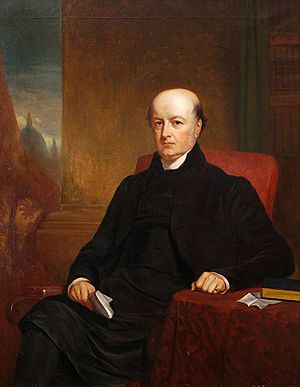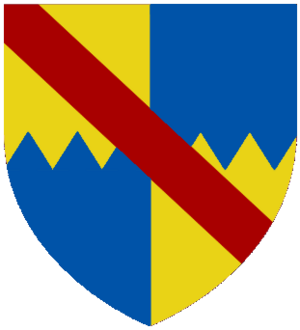Charles James Blomfield facts for kids
Quick facts for kids The Right Reverend and Right Honourable Charles James Blomfield |
|
|---|---|
| Bishop of London | |
 |
|
| Church | Church of England |
| Diocese | London |
| Elected | 1828 |
| Reign ended | 1856 (ill health) |
| Predecessor | William Howley |
| Successor | Archibald Campbell Tait |
| Other posts | Bishop of Chester 1824–1828 |
| Orders | |
| Ordination | 1810 |
| Consecration | c. 1824 |
| Personal details | |
| Born | 29 May 1786 Bury St Edmunds, Suffolk, Great Britain |
| Died | 5 August 1857 (aged 71) |
| Buried | All Saints Church, Fulham |
| Nationality | British |
| Denomination | Anglican |
| Residence | Fulham Palace, London |
| Children | 17 (& 1 stepson), including:
|
| Education | King Edward VI School, Bury St Edmunds |
| Alma mater | Trinity College, Cambridge |
Charles James Blomfield (born May 29, 1786 – died August 5, 1857) was an important British church leader and a expert in ancient Greek and Roman texts. He served as a Church of England bishop for 32 years.
Contents
Who Was Charles James Blomfield?
Charles James Blomfield was born in Bury St Edmunds, Suffolk. He was the oldest of ten children. His father and grandfather were both schoolmasters. This was quite unusual because most bishops at the time came from very wealthy or noble families.
He went to the grammar school in Bury St Edmunds. He even had a short time at Eton College, a famous school, but decided not to take a scholarship there.
His Time at Cambridge University
In 1804, Charles went to Trinity College, Cambridge. He was a very bright student. He won several awards for his writing in Latin and Greek.
He earned his first degree in 1808. He was one of the top students in mathematics and classics. He continued his studies, earning more degrees over the years.
His Career as a Church Leader
Charles Blomfield was elected to a special position at Trinity College in 1809. He also started his career as a scholar, editing important ancient Greek plays and writings.
However, he soon focused more on his church work. He became a deacon in March 1810 and a priest in June 1810. He held several church jobs in different towns.
In 1817, he became a private chaplain to William Howley, who was then the Bishop of London. A chaplain is like a personal priest or advisor.
Becoming a Bishop
In 1824, Charles Blomfield became the Bishop of Chester. As bishop, he made many important changes to improve the church there.
In 1828, he was appointed to the Privy Council. This is a group of advisors to the King or Queen. He then became the Bishop of London, a very important role. He held this job for 28 years. He was also the youngest Bishop of London at the time.
He was known for his energy and dedication. He helped the church become more influential. He was also a skilled speaker in the House of Lords, which is part of the British Parliament.
He played a big part in reforming the church. He also helped expand the church's presence in other countries. He was good at settling disagreements, especially during the Tractarian movement, which was a time of debate within the church.
In 1840, he performed the marriage ceremony for Queen Victoria and Prince Albert. Between 1833 and 1841, he officially opened four of London's large new cemeteries. He also made many changes to Fulham Palace, where he lived, including planting many trees that are still there today.
Later Life and Legacy
In 1856, Charles Blomfield had to step down as bishop because of poor health. He was allowed to keep Fulham Palace as his home and received a pension.
He passed away on August 5, 1857. He is buried in the churchyard of All Saints Church, Fulham, in London. There is also a memorial to him in Saint Paul's Cathedral.
His Writings
Besides his work on ancient texts, Charles Blomfield also published many other writings. These included sermons, lectures, and a book of prayers. He often wrote articles for magazines, mostly about classical subjects.
His Family Life
Charles Blomfield married Anna Maria Heath in 1810. They had six children together, but sadly, most of them died very young. Anna Maria passed away in 1818.
He then married Dorothy Cox in 1819. Dorothy was a widow and already had one son. Charles and Dorothy had eleven more children together. This made their household at Fulham Palace one of the largest for a Bishop of London.
His children included:
- Arthur William Blomfield, a famous architect.
- Lucy Elizabeth Bather, who wrote children's books under the name "Aunt Lucy."
- Alfred Blomfield, who also became a bishop.
Charles Blomfield had many grandchildren and even great-grandchildren who became notable people in various fields, such as architecture, poetry, and science.




